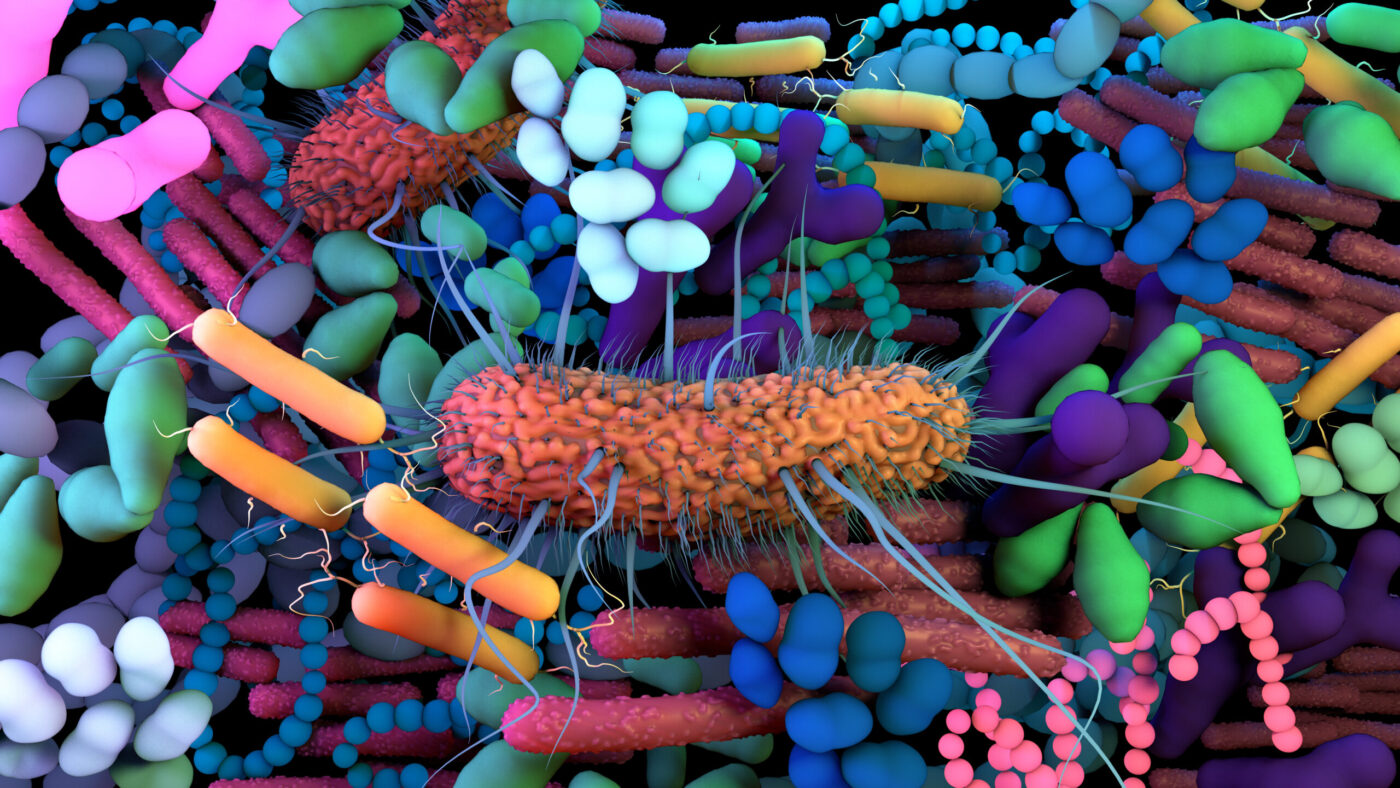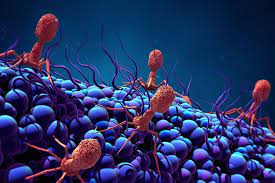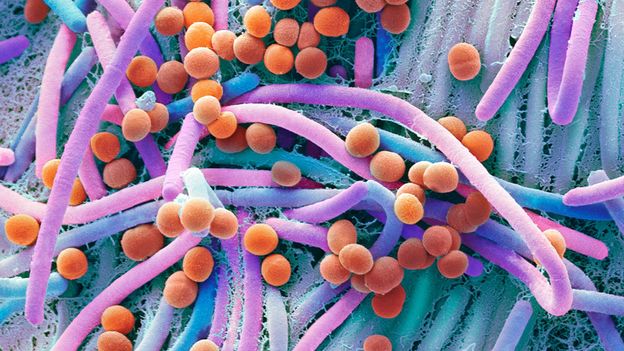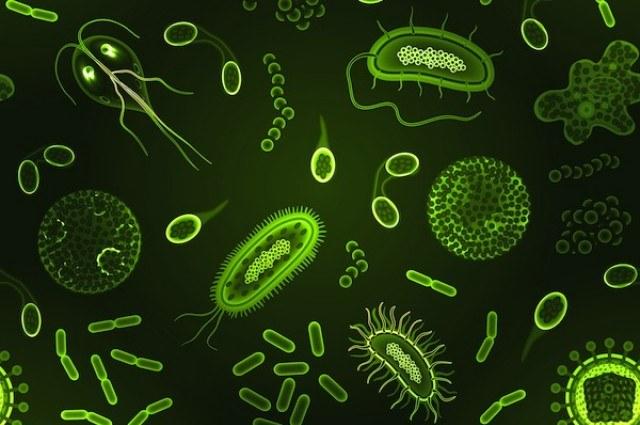GIẢI CHI TIẾT và DỊCH HOÀN THIỆN ĐỀ THI IELTS READING:
I contain multitudes

Wendy Moore reviews Ed Yong’s book about microbes.
Wendy Moore đánh giá sách về vi trùng của Ed Yong
Microbes, most of them bacteria, have populated this planet since long before animal life developed and they will outlive us. Invisible to the naked eye, they are ubiquitous. They inhabit the soil, air, rocks and water and are present within every form of life, from seaweed and coral to dogs and humans. And, as Yong explains in his utterly absorbing and hugely important book we mess with them at our peril. ĐOẠN 1
Vi trùng, hầu hết chúng là vi khuẩn cư trú trên hành tinh này kể từ rất lâu trước khi đời sống động vật phát triển và chúng sẽ tồn tại lâu hơn chúng ta. Vô hình với mắt thường nhưng chúng tồn tại khắp nơi. Chúng sống ở đất, không khí, đá và nước và có mặt trong mọi dạng sống, từ rong biển và san hô đến chó và con người. Và, như Yong giải thích trong cuốn sách cực kỳ hấp dẫn và vô cùng quan trọng mà nếu chúng ta gây rối với chúng sẽ nguy hiểm cho chúng ta.
Every species has its own colony of microbes, called a ‘microbiome’, and these microbes vary not only between species but also between individuals and within different parts of each individual. What is amazing is that while the number of human cells in the average person is about 30 trillion, the number of microbial ones is higher – about 39 trillion. At best, Yong informs us, we are only 50 per cent human. Indeed, some scientists even suggest we should think of each species and its microbes as a single unit, dubbed a ‘holobiont’. ĐOẠN 2
Mỗi loài có đều có một quần thể vi trùng riêng gọi là " microbiome" và những loại vi trùng này khác nhau không chỉ giữa các loài mà còn giữa các cá thể và trong nhiều phần khác nhau của mỗi cá thể. Điều ngạc nhiên là mặc dù số lượng tế bào của con người trong một con người bình thường là khoảng 30 nghìn tỷ nhưng số lượng tế bào vi sinh vật cao hơn, khoảng 39 triệu. Yong cho chúng ta biết, trong điều kiện tốt nhất, chúng ta chỉ là 50 phần trăm con người. Thực vậy, một vài nhà khoa học thậm chí cho rằng chúng ta nên nghĩ về mỗi loài và vi trùng của nó như một đơn vị riêng lẻ được gọi là " holobiont"

In each human there are microbes that live only in the stomach, the mouth or the armpit and by and large they do so peacefully. So ‘bad’ microbes are just microbes out of context. Microbes that sit contentedly in the human gut (where there are more microbes than there are stars in the galaxy) can become deadly if they find their way into the bloodstream. These communities are constantly changing too. The right hand shares just one-sixth of its microbes with the left hand. And, of course, we are surrounded by microbes. Every time we eat, we swallow a million microbes in each gram of food; we are continually swapping microbes with other humans, pets and the world at large. ĐOẠN 3
Trong mỗi con người có những vi trùng chỉ sống trong bụng, miệng hoặc nách và nói chúng chung sống rất hòa bình. Vì vậy, vi trùng xấu chỉ là những loài vi trùng nằm ngoài phạm vi. Vi trùng sống yên ổn trong ruột của con người ( nơi mà có nhiều vi trùng hơn những vì sao trong ngân hà) có thể trở nên gây chết người nếu chúng đi vào trong máu. Những cộng đồng này cũng liên tục thay đổi. Tay phải chỉ có chung 1/6 vi trùng của nó với tay trái. Và dĩ nhiên chúng ta được bao quanh bởi vi trùng. Mỗi khi chúng ta ăn, chúng ta nuốt một triệu vi trùng trong mỗi lạng thức ăn; chúng ta trao đổi vi trùng liên tục với những người khác, vật nuôi và thế giới nói chúng.
It’s a fascinating topic and Yong, a young British science journalist, is an extraordinarily adept guide. Writing with lightness and panache, he has a knack of explaining complex science in terms that are both easy to understand and totally enthralling. Yong is on a mission. Leading us gently by the hand, he takes us into the world of microbes – a bizarre, alien planet – in a bid to persuade us to love them as much as he does. By the end, we do. ĐOẠN 4

1. Mua bộ đề gần 400 bài ielts reading - Dịch và giải chi tiết Chỉ 199k bao gồm toàn bộ đề trong bộ Cambridge ( từ bộ 1 -19) và nhiều đề thi thực tế ( xem danh sách 400 đề ielts reading tại đây). Xem bài mẫu tại đây, Bài mẫu 1, bài mẫu 2, bài mẫu 3. Giải đề bao gồm phần dịch bài đọc, dịch phần câu hỏi, giải thích chi tiết, ( chỉ có thể tải, in phần đề để luyện tập, phần giải chi tiết và dịch chỉ xem online).
>>>> >>>> Đặc biệt tặng kèm Dịch và giải chi tiết bộ đề Ielts listening từ Cam 10-18 và tặng kèm hơn 300 đề Ielts thực tế ( không có lời giải chi tiết chỉ có đề và đáp án) ( khác với bộ 400 đề ở trên). Vui lòng điền thông tin theo form tại đây và thanh toán theo thông tin CK trong form.
2. Đặc biệt dành tặng 100 bạn hoàn thành buổi học thử miễn phí khóa học Ielts Speaking online 1 kèm 1, các bạn sẽ được tặng bộ đề 400k bài Ielts reading và bộ đề Ielts Listening bộ Cam từ 10-18 gồm bài dịch và giải chi tiết, giải thích từ vựng khó ( thời hạn sử dụng trong vòng 2 tháng). Xem thông tin khóa học Ielts Speaking online 1 kèm 1 và đăng ký học thử tại đây.
For most of human history we had no idea that microbes existed. The first man to see these extraordinarily potent creatures was a Dutch lens-maker called Antony van Leeuwenhoek in the 1670s. Using microscopes of his own design that could magnify up to 270 times, he examined a drop of water from a nearby lake and found it teeming with tiny creatures he called ‘animalcules’. It wasn’t until nearly two hundred years later that the research of French biologist Louis Pasteur indicated that some microbes caused disease. It was Pasteur’s ‘germ theory’ that gave bacteria the poor image that endures today. ĐOẠN 5
Yong’s book is in many ways a plea for microbial tolerance, pointing out that while fewer than one hundred species of bacteria bring disease, many thousands more play a vital role in maintaining our health. The book also acknowledges that our attitude towards bacteria is not a simple one. We tend to see the dangers posed by bacteria, yet at the same time, we are sold yoghurts and drinks that supposedly nurture ‘friendly’ bacteria. In reality, says Yong, bacteria should not be viewed as either friends or foes, villains or heroes. Instead, we should realise we have a symbiotic relationship, that can be mutually beneficial or mutually destructive. ĐOẠN 6
What then do these millions of organisms do? The answer is pretty much everything. New research is now unravelling the ways in which bacteria aid digestion, regulate our immune systems, eliminate toxins, produce vitamins, affect our behaviour and even combat obesity. ‘They actually help us become who we are,’ says Yong. But we are facing a growing problem. Our obsession with hygiene, our overuse of antibiotics and our unhealthy, low-fibre diets are disrupting the bacterial balance and may be responsible for soaring rates of allergies and immune problems, such as inflammatory bowel disease (IBD). ĐOẠN 7
The most recent research actually turns accepted norms upside down. For example, there are studies indicating that the excessive use of household detergents and antibacterial products actually destroys the microbes that normally keep the more dangerous germs at bay. Other studies show that keeping a dog as a pet gives children early exposure to a diverse range of bacteria, which may help protect them against allergies later. ĐOẠN 8
The readers of Yong’s book must be prepared for a decidedly unglamorous world. Among the less appealing case studies is one about a fungus that is wiping out entire populations of frogs and that can be halted by a rare microbial bacterium. Another is about squid that carry luminescent bacteria that protect them against predators. However, if you can overcome your distaste for some of the investigations, the reasons for Yong’s enthusiasm become clear. The microbial world is a place of wonder. Already, in an attempt to stop mosquitoes spreading dengue fever – a disease that infects 400 million people a year – mosquitoes are being loaded with a bacterium to block the disease. In the future, our ability to manipulate microbes means we could construct buildings with useful microbes built into their walls to fight off infections. Just imagine a neonatal hospital ward coated in a specially mixed cocktail of microbes so that babies get the best start in life. ĐOẠN 9
Xem thêm:
♦ Tổng hợp câu trả lời, câu hỏi, từ vựng của hơn 70 chủ đề Ielts Speaking part 1
♦ Tổng hợp gần 400 đề thi Ielts reading ( bao gồm dịch, giải chi tiết, từ vựng)
Questions 14-16
Choose the correct letter, A, B, C or D.
Write the correct letter in boxes 14-16 on your answer sheet.
14 What point does the writer make about microbes in the first paragraph?
A They adapt quickly to their environment.
B The risk they pose has been exaggerated.
C They are more plentiful in animal life than plant life.
D They will continue to exist for longer than the human race.
15 In the second paragraph, the writer is impressed by the fact that
A each species tends to have vastly different microbes.
B some parts of the body contain relatively few microbes.
C the average individual has more microbial cells than human ones.
D scientists have limited understanding of how microbial cells behave.
16 What is the writer doing in the fifth paragraph?
A explaining how a discovery was made
B comparing scientists’ theories about microbes
C describing confusion among scientists
D giving details of how microbes cause disease
Questions 17-20
Complete the summary using the list of words, A-H, below.
Write the correct letter, A-H, in boxes 17-20 on your answer sheet.
We should be more tolerant of microbes
Yong’s book argues that we should be more tolerant of microbes. Many have a beneficial effect, and only a relatively small number lead to 17 ………………… . And although it is misleading to think of microbes as ‘friendly’, we should also stop thinking of them as the enemy. In fact, we should accept that our relationship with microbes is one based on 18 ………………… .
New research shows that microbes have numerous benefits for humans. Amongst other things, they aid digestion, remove poisons, produce vitamins and may even help reduce obesity. However, there is a growing problem. Our poor 19 …………………, our overuse of antibiotics, and our excessive focus on 20 ………………… are upsetting the bacterial balance and may be contributing to the huge increase in allergies and immune system problems.
A solution B partnership C destruction
D exaggeration E cleanliness F regulations
G illness H nutrition
Questions 21-26
Do the following statements agree with the claims of the writer in Reading Passage 2?
In boxes 21-26 on your answer sheet, write
YES if the statement agrees with the claims of the writer
NO if the statement contradicts the claims of the writer
NOT GIVEN if it is impossible to say what the writer thinks about this
21 It is possible that using antibacterial products in the home fails to have the desired effect.
22 It is a good idea to ensure that children come into contact with as few bacteria as possible.
23 Yong’s book contains more case studies than are necessary.
24 The case study about bacteria that prevent squid from being attacked may have limited appeal.
25 Efforts to control dengue fever have been surprisingly successful
26 Microbes that reduce the risk of infection have already been put inside the walls of some hospital wards.
ĐÁP ÁN, GIẢI CHI TIẾT và DỊCH HOÀN THIỆN ĐỀ THI IELTS READING: I contain multitudes

Questions 14-16
Choose the correct letter, A, B, C or D.
Write the correct letter in boxes 14-16 on your answer sheet.
14 What point does the writer make about microbes in the first paragraph?
Người viết đưa ra quan điểm về vi khuẩn trong đoạn đầu
A They adapt quickly to their environment.
Chúng thích nghi nhanh với môi trường
B The risk they pose has been exaggerated.
Nguy hiểm mà chúng tạo ra bị làm quá lên
C They are more plentiful in animal life than plant life.
Chúng nhiều hơn trong sinh vật động vật so với trong sinh vật cây trồng
D They will continue to exist for longer than the human race.
Chúng sẽ tồn tại liên tục lâu hơn loài người
Giải thích: đoạn 1
Microbes, most of them bacteria, have populated this planet since long before animal life developed and they will outlive us
Questions 17-20
Complete the summary using the list of words, A-H, below.
Write the correct letter, A-H, in boxes 17-20 on your answer sheet.
We should be more tolerant of microbes
Chúng ta nên chấp nhận vi khuẩn hơn nữa
Yong’s book argues that we should be more tolerant of microbes. Many have a beneficial effect, and only a relatively small number lead to 17 …G…illness …………… .
Sách của Yong lập luận rằng chúng ta nên chấp nhận vi trùng hơn nữa. Nhiều loại có ảnh hưởng có lợi, và chỉ một số lượng nhỏ tương đối gây ra bệnh
Giải thích: đoạn 6
Yong’s book is in many ways a plea for microbial tolerance, pointing out that while fewer than one hundred species of bacteria bring disease (= only a relatively small number lead to illness) , many thousands more play a vital role in maintaining our health.
……………………………………………………………………………………………
And although it is misleading to think of microbes as ‘friendly’, we should also stop thinking of them as the enemy. In fact, we should accept that our relationship with microbes is one based on 18 B……partnership …………… .
Và mặc dù sai lầm khi nghĩ về vi trùng là thân thiện, chúng ta cũng nên ngừng suy nghĩ về chúng như kẻ thù. Thực tế, chúng ta nên chấp nhận rằng mối quan hệ với vi trùng là mối quan hệ dựa trên sự hợp tác.
Giải thích: đoạn 6
We tend to see the dangers posed by bacteria, yet at the same time we are sold yoghurts and drinks that supposedly nurture ‘friendly’ bacteria. In reality, says Yong, bacteria should not be viewed as either friends or foes, villains or heroes. Instead we should realise we have a symbiotic relationship( = partnership), that can be mutually beneficial or mutually destructive.
Questions 21-26
Do the following statements agree with the claims of the writer in Reading Passage 2?
In boxes 21-26 on your answer sheet, write
YES if the statement agrees with the claims of the writer
NO if the statement contradicts the claims of the writer
NOT GIVEN if it is impossible to say what the writer thinks about this
21.T It is possible that using antibacterial products in the home fails to have the desired effect.
Có thể việc sử dụng sản phẩm kháng khuẩn tại nhà không có những hiệu quả mong muốn
Giải thích: đoạn 8, các sản phẩm kháng khuẩn tiêu diệt vi khuẩn giúp ngăn chặn nguy hiểm cho chúng ta, tức là nó không mang lại hiệu quả mong muốn.
For example, there are studies indicating that the excessive use of household detergents and antibacterial products actually destroys the microbes that normally keep the more dangerous germs at bay.
22.F It is a good idea to ensure that children come into contact with as few bacteria as possible.
Đảm bảo trẻ em hình thành sự tiếp xúc với ít vi khuẩn nhất có thể là suy nghĩ tốt
Giải thích: đoạn 8, trẻ em nên tiếp xúc với đa dạng vi khuẩn sớm từ thú cưng trong nhà chẳng hạn, giúp chúng chống lại dị ứng
Other studies show that keeping a dog as a pet gives children early exposure to a diverse range of bacteria, which may help protect them against allergies later.

1. Mua bộ đề gần 400 bài ielts reading - Dịch và giải chi tiết Chỉ 199k bao gồm toàn bộ đề trong bộ Cambridge ( từ bộ 1 -19) và nhiều đề thi thực tế ( xem danh sách 400 đề ielts reading tại đây). Xem bài mẫu tại đây, Bài mẫu 1, bài mẫu 2, bài mẫu 3. Giải đề bao gồm phần dịch bài đọc, dịch phần câu hỏi, giải thích chi tiết, ( chỉ có thể tải, in phần đề để luyện tập, phần giải chi tiết và dịch chỉ xem online).
>>>> >>>> Đặc biệt tặng kèm Dịch và giải chi tiết bộ đề Ielts listening từ Cam 10-18 và tặng kèm hơn 300 đề Ielts thực tế ( không có lời giải chi tiết chỉ có đề và đáp án) ( khác với bộ 400 đề ở trên). Vui lòng điền thông tin theo form tại đây và thanh toán theo thông tin CK trong form.
2. Đặc biệt dành tặng 100 bạn hoàn thành buổi học thử miễn phí khóa học Ielts Speaking online 1 kèm 1, các bạn sẽ được tặng bộ đề 400k bài Ielts reading và bộ đề Ielts Listening bộ Cam từ 10-18 gồm bài dịch và giải chi tiết, giải thích từ vựng khó ( thời hạn sử dụng trong vòng 2 tháng). Xem thông tin khóa học Ielts Speaking online 1 kèm 1 và đăng ký học thử tại đây.
ĐÁP ÁN:
14 D
15 C
16 A
17 G
18 B
19 H
20 E
21 YES
22 NO
23 NOT GIVEN
24 YES
25 NOT GIVEN
26 NO

.png)





